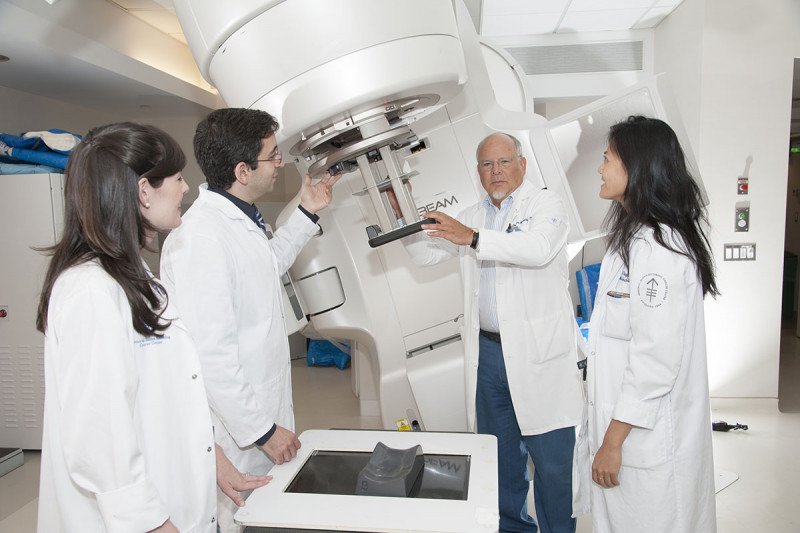
Very low-dose radiotherapy (VLDRT) is effective for treating grade 3A follicular lymphoma and provides patients with a shorter treatment course and fewer side effects.
We observed outstanding radiographic responses, local control, and associated palliative benefits in our recent retrospective analysis of ten consecutive patients with grade 3A follicular lymphoma who were treated at Memorial Sloan Kettering Cancer Center. Grade 3A follicular lymphoma showed comparable radiosensitivity to low-grade follicular lymphoma (grades 1 and 2) with VLDRT of 4 gray (Gy). (1)
Our report was published recently as a Letter to the Editor in the journal Leukemia & Lymphoma. To our knowledge, it was the first study of a dedicated series of high-grade follicular lymphoma treated with VLDRT.
At MSK, we are committed to maximizing patient outcomes while minimizing exposure to unnecessary treatments. The findings from our retrospective cohort support an expanded evaluation of VLDRT in patients with higher-grade follicular lymphoma.
The Rationale for a “Less Is More” Strategy
VLDRT has typically been used to treat patients with low-grade histology (grades 1 and 2). Grade 3B cancer is considered an aggressive malignancy similar to diffuse large B cell lymphoma. However, there has been considerable debate about whether to classify grade 3A disease as indolent or aggressive. (2), (3), (4), (5), (6), (7)
The International Lymphoma Radiation Oncology Group recently conducted a multi-institutional analysis of definitive radiotherapy of more than 24 Gy for localized follicular lymphoma, including patients with grade 3A histology. The results showed no significant disadvantage for patients with grade 3A cancer compared to patients with lower-grade disease in terms of disease progression (hazard ratio=0.90, 95 percent CI: 0.50–1.63, p=0.73). (3)
Based on these results, we hypothesized that grade 3A follicular lymphoma might display similar radiosensitivity characteristics as grades 1 and 2 disease.
Study Design
We analyzed data from a consecutive series of ten patients with follicular lymphoma — grade 3A or grade 3 not otherwise classified — who received two fractions of 2 Gy to treat the disease between 2005 and 2013. (1)
The cohort was heterogeneous, with a median age of 71 years (range 52 to 92), and 70 percent of the group were female. Response at the first assessment post-VLDRT took place at a median follow-up time of 1.7 months (range of 1.0 to 4.2). Patients were evaluated by PET/CT, where available, using the Lugano criteria. (8)
Study Results
Among the ten patients in the series, two received VLDRT palliatively for newly diagnosed disease, three were treated for progression after initial follow-up (range 1.5 to 7 years), and five had relapsed disease. Note that the relapsed patients were heavily pretreated: They had received three to five lines of prior therapy. (1)
Despite disease heterogeneity among the patients, the overall response rate was 100 percent at the first post-treatment assessment, with six complete responses and four partial responses. There were no adverse events, and seven patients who were symptomatic before VLDRT reported clinical improvement at the first reassessment. (1)
Overall, there were four distant failures, corresponding to a freedom from distant failure rate of 67 percent (95 percent CI: 27–88 percent) at one year. Following initial treatments, two patients received additional treatments with VLDRT alone, and a third patient received a full radiotherapy (RT) dose of 30 Gy following local failure. (1)
This last patient illustrates a strategy we are increasingly adopting at MSK for patients with low-grade follicular lymphoma. Patients can opt to have VLDRT with short-interval radiographic and clinical reassessments, and then proceed to full-dose RT if the cancer does not respond optimally to VLDRT. Short interval restaging enables us to identify patients who would benefit from dose escalation and spare others from unnecessary treatment.
Advancing Lymphoma Research
At MSK, we are committed to improving patient outcomes and minimizing the adverse effects of cancer treatment through evidence-based research. Our Lymphoma Service includes experts across multiple disciplines, including hematology, medical oncology, radiology, radiation oncology, pathology, genetics, bone marrow transplant, and symptom management. We collaborate to develop individualized care plans for each patient.
We are currently conducting more than 70 clinical trials for patients with lymphoma, exploring novel combinations of targeted therapies and looking for new biomarkers to predict disease relapse.
- A Phase II Study of Pembrolizumab Immunotherapy plus Involved Site Radiation Therapy to Treat Early Recurrent or Persistent Hodgkin Lymphoma
- A Pilot Study of Pembrolizumab Immunotherapy in Patients with Extranodal NK/T Cell Nasal-Type Lymphoma
- A Phase I/II Study of Mogamulizumab and Pembrolizumab Immunotherapy in Recurrent and Persistent Advanced Lymphoma
- A Phase I Study of JNJ-67856633 for Patients with Non-Hodgkin Lymphoma and Chronic Lymphocytic Leukemia
Dr. Imber is a radiation oncologist who finishes his training this summer. He will join the radiation oncology hematological malignancies team and will focus on treating patients with lymphoma and myeloma at MSK’s Long Island and Manhattan campuses. Dr. Yahalom is the co-leader of the Lymphoma Disease Management Team, a radiation oncologist, and a lymphoma expert at MSK who is internationally recognized for lymphoma research. He is also the founder and chair of the International Lymphoma Radiation Oncology Group, which developed and harmonized the modern radiation guidelines for Hodgkin lymphoma and lymphoma involving all organ sites.
